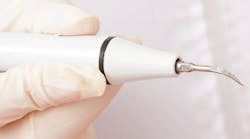The Hygiene Message in a Bottle Mailbag is a monthly feature of the e-newsletter, Pearls for Your Practice: The Product Navigator. Each month, Colleen Olson, RDH, BBA, the editorial director of the Hygiene Product Navigator, will answer reader-submitted questions to help you navigate your dental hygiene product decisions (and more!). This month, she provides an update to her July 2016 mailbag, which covered the efficacy of chlorhexidine as an irrigant during ultrasonic scaling.
In August, the Journal of Clinical Periodontology published a systematic review examining the effect of using chemotherapeutic solutions in an ultrasonic device on the outcome of nonsurgical periodontal therapy. (1) This review included 14 publications that evaluated the effectiveness of chemotherapeutic agents on reducing probing pocket depths and improving clinical attachment levels.
The studies included in the review examined a variety of irrigant agents and used various ultrasonic devices. The most commonly tested irrigant among these publications was povidone-iodine, followed by chlorhexidine, and lastly essential oils in water. Each agent was compared to water, saline, or placebo solution. The authors of this systematic review noted that it is generally difficult to research in this area because nonsurgical periodontal therapy by itself is an effective treatment. Since nonsurgical periodontal therapy alone is so effective, it is challenging to illustrate even small added benefits of local therapeutic agents.
The authors found little overall effect from the addition of chemotherapeutic agents to ultrasonic scaling during nonsurgical periodontal debridement. They concluded: “There is a ‘very weak’ recommendation based on the subanalysis showing that, for [povidone-iodine], a very small level of [clinical attachment level] gain may be expected. For the use of [chlorhexidine] or [essential oils], the added effect can be considered ‘zero.’” Based on the evidence of no significant effect and the added cost of a chemotherapeutic agent, I will continue to use water as an ultrasonic irrigant for my periodontal patients.
Reference
1. Van der Sluijs M, Van der Sluijs E, Van der Weijden F, Slot DE. The effect on clinical parameters of periodontal inflammation following non-surgical periodontal therapy with ultrasonics and chemotherapeutic cooling solutions: a systematic review. J Clin Periodontol. 2016;43:1074-1085.
Editor's note: Do you have a question for Colleen? Is there a product you'd like to see her review? Or would you like to submit your own hygiene product article? Send an email to [email protected]. You might just see it in the Hygiene Product Navigator! If you're not a Product Navigator subscriber, click here to sign up.
More reading
December 2016 |Relief for patients with root exposure and sensitivity
November 2016 | Fluoride varnish and fluorosis
October 2016 | Prophy paste grit and its effects on enamel








